Some time ago, we were contacted with a question concerning a very popular revolver cartridge – the 357 Magnum. This cartridge is an effective choice for personal defense, and a solid choice for small game and predator control. With a long-barrel handgun and careful load selection, the 357 Magnum is even suitable for deer-sized game. However, this readers question took a different path. The question was, does the 357 Magnum have enough bullet weight and penetration for effective defense against wild animals? The fact is, the 357 Magnum is probably the most common handgun caliber that is packed solely for protection against animals. Quite a few Combat Magnums, Blackhawks, and Trackers do double duty in the wild. Whether it is the best choice is open to interpretation, but it is the largest caliber the occasional shooter is likely to wish to attempt to master. Calibers smaller than the 357 Magnum – the 38 Special and 32 Magnum – are too light, small, and slow for effective use against larger animals. Big-bore revolvers such as the 44 Magnum are heavier, making them more difficult to holster and carry comfortably. The boomers are much more difficult to control, with close to twice the recoil of the 357 Magnum. The 357 Magnum is the most powerful cartridge that the average shooter will be able to control, given a handgun of sufficient weight and modest practice. A guy or girl who carries a snub 38 Special for protection and practice will be able to control a mid-size 357 Magnum revolver for occasional use and peace of mind on the trail.
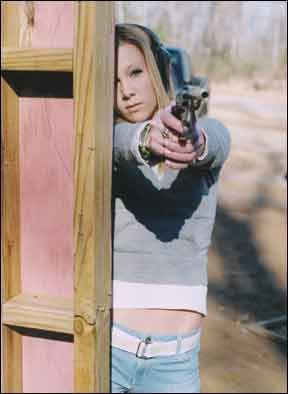
Photos Courtesy of MidwayUSA.com
The advantages of the revolver have proven out in defense against animals. In more than one case, a person was bowled over by a charging cougar or bear. The defensive handgun was placed against the animals body and the trigger pressed until the desired effect took place. A self-loader would jam after the first shot in such a situation. The facts simply bear us out on this one. In most cases the animal attacks quickly, and it is literally on top of the person, biting and clawing before the victim has time to draw the handgun. The handgun is used at intimate range. While there may be exceptions to the rule, the revolver is a wise choice for this type of personal defense. As for cartridges, we would prefer something larger, but then, the 357 Magnum has been known to suffice. Remember, there is a great difference in hunting and defense and between taking a careful shot and placing a bullet in the heart of a creature and producing a quick, clean kill and actually stopping an attack. Only a cartridge with sufficient bullet integrity to penetrate deeply and break large bones and produce a wound to the blood bearing organs is suitable. Even the skull of some animals is quite thick and resistant to light bullets. As an example, we are aware of a case in which a game warden fired five rounds into the skull of a bear and only one penetrated – the stopping stop. He was using fast-opening 125-grain JHP bullets. Penetration is vital. Some expansion would be ideal, but in the end we have to sacrifice expansion for penetration. If the projected threat is one of the big cats or the dangerous feral dogs, then an expanding bullet is ideal, as long as it has sufficient penetration to perforate the creature. If you are in bear country, then a heavy, non-expanding bullet is needed.
The question was relevant on another level – can a self-defense shooter simply change loads and have a viable outdoors revolver for protection against bears? This question would eliminate testing the 6- to 8-inch-barrel revolvers we normally consider hunting revolvers. Could a defense-minded shooter who normally deploys a 110-grain load in his 357 be loaded for bear if he simply changed bullet weights? This is an intriguing question. Normally, heavy bullets with little expansion are contraindicated for personal defense, but not in this scenario.
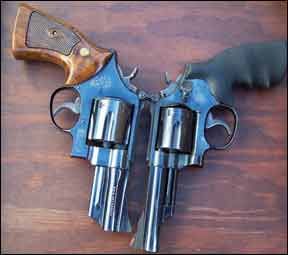
We elected to test several loads that are advertised as heavy loads, and loads that offer sufficient expansion and penetration for use against animals. We threw in a number of general-purpose loads and personal-defense loads as well. Some were recommended by readers or the raters we worked with on this subject. While penetration and ballistic effect is foremost, accuracy is also interesting. These were among the most accurate handgun loads we have ever tested. Since the 357 Magnum is a very popular cartridge, there was no shortage of ammunition available. We leaned toward heavier bullets, but we also tested several personal defense loadings for comparison, simply to confirm our suspicions that these loads did not generate sufficient penetration for use against bear size animals. Wild hogs can be dangerous, and they are in the large and dangerous category. If your problem is feral dogs or the big cats, the first three loads are interesting choices.
A word on shot placement – one of our more experienced shooters noted that when taking coyote and the like with the 357, the best effect occurred when the bullet struck at a raking angle. When the bullet traveled from front to back and completely passed through the body, the effect was immediate. Our long-time police officer noted that people often make a bad mistake when attempting to take down charging drug-dealer guard dogs and feral dogs as well. If firing at the front of the animal when the animal charges, shooters aim too low in the chest. The bullet simply exits the chest after making a grazing wound that is not fatal. Aiming higher, above the spot the collar would normally ride, results in a shot that travels downward to the organs. This rater carries the 180-grain JHP Federal load in his personal Magnum. Having seen the effect of this load on deer-size animals, he is conversant with the power of the load and it is he that gave us the warning on this placement. Paying attention to details such as this will ensure that you are not one of the individuals killed each year by animal attacks. Those who have seen the effect of the 357 Magnum on both men and game and greatly respect the caliber.
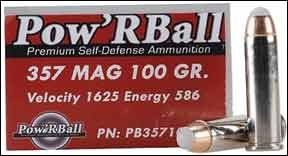
Lighter Loads
From www.MidwayUSA.com, we bought the Winchester USA 110-grain JHP Q4204, $26.99/50, Cor-Bons 100-grain PowRBall PB357100, $21.99/20, and Federals 130-grain Hydra-Shok PD357HS2 H, $25.99/20. We fired these cartridges using standard Gun Tests criteria that includes accuracy and reliability testing, then penetration tests firing the loads into 6-inch-thick water jugs.
We found the Winchester USA load to be very controllable and reasonably accurate. It is not produced to be the most powerful load; rather, as a controllable personal defense load. The PowRBall is a fast load with a light bullet and the least subjective recoil of any load tested. The polymer ball in the nose, when used in a cartridge designed to be used in an automatic pistol, ensures feed reliability. Cor-Bon claims the polymer tip also ensures expansion in revolver cartridges when meeting intermediate obstacles. There is no hollowpoint to plug with denim or other material. Our tests confirmed that Cor-Bons marketing claims are correct – the PowRBall performs as designed, fragmenting in water as befits an urban load. In fact, the PowRBall load and the Winchester load both fragmented. Performance for these lighter loads is similar, in our assessment.
The Federal 130-grain Hydra-Shok was the fastest light bullet load tested by a considerable margin. Blistering out of our 4-inch-barrel revolver at 1480 fps, the Hydra-Shok is obviously designed for maximum performance. Yet, recoil was not harsh. Muzzle flash was subdued. Less experienced raters noticed the difference between the Hydra-Shok loading and others, and Power Factor does not lie.
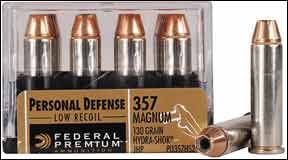
In this weight range, we believe the Hydra-Shoks are the most effective loadings by a wide margin. They are powerful enough to be effective against large dogs and the big cats, if that is your threat profile. The Winchester load is economical, but the performance of the Federal load wins out in totality, we believe. A less-seasoned shooter might find the recoil of the Hydra-Shok offensive, but none of our raters had a problem with the Hydra-Shok loading. The PowRBall load had the least subjective recoil, feeling like it was in 38 Special +P class, despite the high velocity.
The three light loads are obviously designed for personal defense and must be taken on their own merits. But if bears are in the picture, then we need to look further.
Heavyweight Loads
Some of these loads are designed to operate out of heavy-barrel hunting guns. It is possible that the velocity differences may change when fired in long-barrel handguns because slow-burning powder is often used in the Magnums to maximize velocity in long barrels. Just the same, these loads are likely choices to be carried in a personal defense handgun in the wild, so we tested them in a 4-inch barrel. If you use a 6-inch hunting barrel, it is realistic to expect a 100-fps increase in velocity.
Also from www.MidwayUSA, we bought the Buffalo Bore 158-grain JHP 19C, $26.99/20; Cor-Bons Hunter 180-grain HT357180BC-20, $36.99/20; the Black Hills 158-grain JHP M357N3, $37.99/50; Federal Classic Hi-Shok 180-grain JHP C357G $20.49/20; Speer Gold Dot 158-grain JHP 23960 $22.09/20; and the Grizzly Ammunition 180-grain Cast Performance Lead Wide Flat Nose Gas Check GC357M180, $23.49/20.
The Buffalo Bore 158-grain load uses the Gold Dot hollowpoint, the Cor-Bon load is a JSP type, and the Grizzly Cartridge bullet is a hard-cast flat point. The others are hollowpoints. These loads run a gamut of penetration and expansion that is well worth consideration.
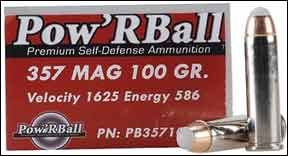
We used a 4-inch-barrel Smith & Wesson revolver to fire our rounds. The Black Hills 158-grain JHP and the Speer Gold Dot were very similar in firing impressions. Both were controllable by our experienced raters, and each exhibited modest muzzle blast. The Federal 180-grain JHP was pleasant to fire as well. The Grizzly Cartridge flatpoint generated more recoil, but it was not unpleasant. The Cor-Bon 180-grain JSP and the Buffalo Bore 158-grain load both demonstrated greater muzzle blast and recoil. However, they are custom loads that also delivered plenty of horsepower. They are designed for hunting and for defense against larger animals. As such, they may not offer a lot of control on a combat course, but it is possible to recover and fire a second shot in a reasonable amount of time. We could not help but think that the heaviest loads with the greatest penetration would be an excellent match for one of the heavy-frame revolvers with an 8-shot cylinder.
We are convinced the 158-grain Gold Dot loading would be a better performer in a long barrel. Penetration was adequate, but even when bumped up to a higher velocity in the Buffalo Bore loading, expansion was modest. Just the same, a lot of energy was expended in slowing down in water. Lets be clear in our criteria for this test – we are looking for through-and-through penetration, which is different from our usual considerations for a lot of expansion and controlled penetration.
The Black Hills load would be the choice for hunting light-skinned game, as it shows excellent expansion. But in the three 158-grain loads, the Buffalo Bore load has the greatest penetration and offered a degree of expansion. This is the top running 158-grain loading, but the Black Hills load is close. The Black Hills load with the Hornady XTP bullet is also by far the most economical and also the most accurate 158-grain load.
The 180-grain loads were designed with different criteria in mind. The Federal load shows excellent expansion. This may surprise some, but in our opinion the Federal 180-grain hollowpoint would be a fine personal defense load for use in those areas in which felons are often heavily clothed during the winter months. It is also a proven deer slayer. But penetration did not qualify this load as a bear stopper, in our opinion.
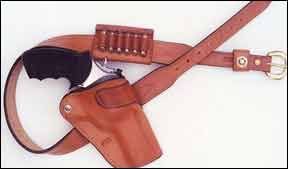
On the other hand the Cor-Bon 180-grain JSP gave fantastic results. Penetration was twice what we experienced with the JHP loads. Here is a full-power loading that exhibits the type of performance the 357 Magnum is famed for. Penetration was over 40 inches and accuracy was first class. There was no expansion, although we expected at least a smearing of the nose in water. The bullet did sometimes expand when intentially fired it into the berm. Early in our test program, we badly miscalculated the amount of water needed to stop the bullet. A gallon water jug is 6 inches thick, and the Cor-Bon shot through six with the first test shot and the bullet kept flying. We used eight jugs in the first test that actually stopped the 180-grain JSP bullet, and the Cor-Bon 180-grain JSP sailed through seven, falling to the bench between the seventh and eighth jug.
The Grizzly Cartridge clocked within 5 fps of the Cor-Bon load. Perhaps each company found the magic spot in velocity for the 180-grain slug. There is no faulting the penetration of the 180-grain flat point; this load also sailed through 40+ inches of water. This load is less expensive than the Cor-Bon load, which may be a factor in your decision, and accuracy excellent. Much depends upon your goal. In a hunting scenario at moderate range, the Cor-Bon load may expand, but it would take a 10-inch-barrel Contender or long-barrel revolver to get velocity up to the best field levels. These two loads also demonstrate something that experienced handgunners have known for years: the 357 Magnum is dangerously overpenetrative for use in an urban environment when loaded with nonexpanding ammunition.
Both of these loads generated over 200 on the Power Factor scale, which we established some time ago as the high side for good control. This too must be taken into consideration. While first-class performers, a less experienced shooter might have difficulty with the recoil of these loads.
The 158-grain Speer Gold Dot load has accuracy and penetration, but the Gold Dot doesnt have much expansion potential at this velocity. The Black Hills load has practically the same velocity, but much better expansion. The Buffalo Bore 158-grain load, which also uses the Gold Dot bullet, has a lot more horsepower. It is 88 fps faster than the Black Hills load and almost 100 fps faster than the Speer load. This is a winner in the 158-grain category, but with a qualifier. The Gun Tests criteria include control. This load is not going to be controllable for some shooters. It should not be used in the five-shot J-frame defense revolvers and probably not used in any revolver lighter than a six-shot K-frame with a 4-inch barrel. The Buffalo Bore load was much more comfortable in one of our raters Model 27 Smith & Wesson revolver, but that is a different story. The Buffalo Bore 158-grain load obviously had the greatest energy and performance, and quality control and accuracy are also excellent. For most of us, the Black Hills load will be enough, and it is boxed 50 rounds to the box. This is a tough one to call, all things considered.
The next step up is to the 180-grain loads. The only JHP in this weight in this test group is the Federal 180-grain bullet. This was a mild load to fire, breaking less than 1100 fps, the slowest load tested. But performance was exactly what has been killing deer-sized game for a generation. Expansion was the greatest of any JHP tested. Accuracy was superb. This load has a lot going for it. But what if we raised the criteria to 30 inches of penetration? It should be noted that some loads that penetrate 30 inches of water per the Gun Tests criteria will not penetrate 30 inches of flesh and blood because bone and tougher muscle will intervene.

























